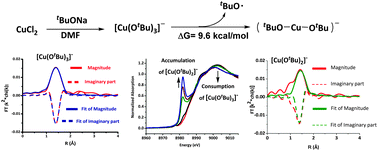Homolytic cleavage of the O–Cu(ii) bond: XAFS and EPR spectroscopy evidence for one electron reduction of Cu(ii) to Cu(i)†
Abstract
The investigation into the active copper(I) catalysts from copper(II) precursors has become a fundamental and important task in copper catalysis. In this work, we demonstrate that the tBuO− anion serves not only as a base but also as a mediator to promote the reduction of Cu(II) to Cu(I) in copper catalysis. XAFS and EPR spectroscopy evidence the [Cu(OtBu)3]− ate complex as the key intermediate which undergoes homolytic-cleavage of the O–Cu(II) bond generating [Cu(OtBu)2]− ate complex.



 Please wait while we load your content...
Please wait while we load your content...